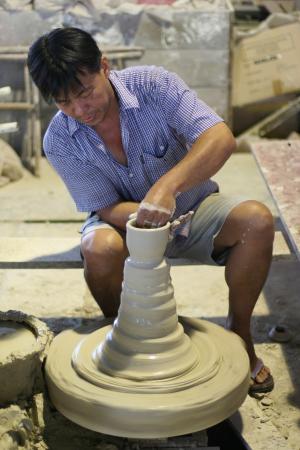Eco-pottery product from water treatment sludge

Pottery making in Sarawak, Malaysia Copyright : Colin Charles / Flickr
Sludge is a by-product of water treatment. Sludge is produced during the clarification and filtration process in the water treatment system. It is also produced from the accumulated solids removed from sedimentation basin or settling tank.
The increasing number of water treatment plants has led to a considerable increase in sludge generation. The disposal of sludge from water treatment operations poses a problem in Malaysia.
The problem is acute because of the scarcity of space to store the sludge. The advantage of water sludge is that it is not considered as hazardous waste.
The objective of this project is to reduce the environmental impact generated by the sludge coming from the Water Treatment Plant (WTP), through a new sludge management concept that introduces a method that re-uses sludge as raw material for the structural pottery industry.
Pottery is the type of ceramic material, which the American Society for Testing and Materials (ASTM) has defined as wall fired ceramic wares that contain clay when formed except technical, structural and refractory product.
The term pottery is also used for a technique involving ceramic, where clay is mixed with other minerals and is formed into objects, including vessels generally designed for utilitarian purposes.
Ceramics have characteristics that enable them to be used in a wide variety of applications including i) high heat capacity and low heat conductivity, ii) corrosion resistance, iii) electrically insulating, semi-conducting, or super conducting, iv) non-magnetic and magnetic, and v) hard and strong, but brittle.
The Eco-pottery is made from water treatment sludge. During the process, the organic substances in the sludge were eliminated through burning, while the heavy metals were safely contained in the product.
Furthermore, energy is saved during the production process since sludge is used as combustion during the burning process. Technically the Eco-pottery has demonstrated that the WTP sludge could be viably used in the mixture to produce pottery. The chemical composition, the energy properties of the sludge and the mineral contained in the sludge were analysed in a laboratory.
Chemical composition is vital because of its effect on the product behaviour. X-ray Fluorescence (XRF) and Total Nitrogen Measurement (TNM) determined the chemical composition of water treatment sludge.
The physical characteristics of the sludge were also tested. The test conducted is moisture content and plasticity of the sludge. The mineral compositions were determined by X-ray Diffraction (XRD) was silica, kaolinite, muscovite, iron oxide and iron hydrogen phosphate.
Water treatment sludge contained high concentration of free silica. The Eco-pottery was made using throwing technique. The samples are then pressed into mould to make prismatic bar each mark with 100mm measurement. Linear shrinkage was determined by measuring the length of the samples before and after the firing stage using a calliper with a precision of ±0.01 mm. Water absorption was done according to the Malaysian Standard, MS ISO 10545-3:2001. Firing properties were obtained by observing whether potteries resistant to low and high temperature.
The results show that water treatment sludge can be used as raw materials in the production of pottery products. This will provide reuse option to water treatment sludge.
FOR MORE INFORMATION :
Azinoor Azida Binti Abu Bakar
Marfiah Ab. Wahid
Faizah Kamarudin
Institute of Infrastructure, Engineering & Sustainable Management (IIESM)
University Teknologi MARA, Malaysia.
Email : azinoor@salam.uitm.edu.my
Media Contact
All latest news from the category: Ecology, The Environment and Conservation
This complex theme deals primarily with interactions between organisms and the environmental factors that impact them, but to a greater extent between individual inanimate environmental factors.
innovations-report offers informative reports and articles on topics such as climate protection, landscape conservation, ecological systems, wildlife and nature parks and ecosystem efficiency and balance.
Newest articles

Long-sought structure of powerful anticancer natural product
…solved by integrated approach. A collaborative effort by the research groups of Professor Haruhiko Fuwa from Chuo University and Professor Masashi Tsuda from Kochi University has culminated in the structure…

Making a difference: Efficient water harvesting from air possible
Copolymer solution uses water-loving differential to induce desorption at lower temperatures. Harvesting water from the air and decreasing humidity are crucial to realizing a more comfortable life for humanity. Water-adsorption…

In major materials breakthrough
UVA team solves a nearly 200-year-old challenge in polymers. UVA researchers defy materials science rules with molecules that release stored length to decouple stiffness and stretchability. Researchers at the University…



